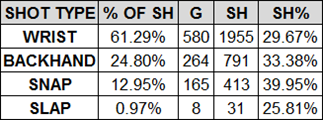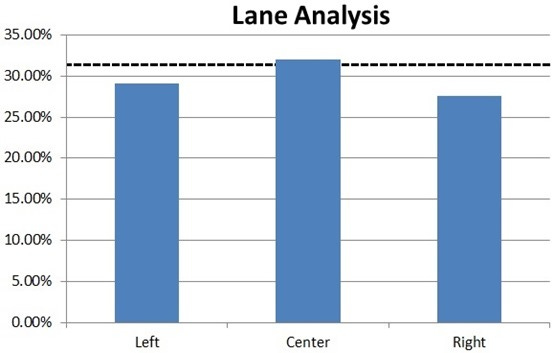Breakaways and shootouts are key moments in any hockey game. It’s known that the shooter should score around 1 in 3 chances alone against the goalie (~33%). Bottom shooters score around 20% and top shooters are closer to a 40% success rate. In the shootout, the elite can eclipse 50%. Panarin is the highest active player at 61%
What’s the difference?
Understanding the Goalie
From Mitch Korn’s “Playing the breakaway.”
THE GOALTENDER’S SYSTEM
1. Challenge the shooter: Come out well above the top of the goal crease and get set. This leaves little angle for a shot and forces a sharp player to deke.
2. Back up: Goaltenders backward momentum toward their net as they close the gap between the goalie and shooter.
3. Save Selection: This is the save choice the goalie makes. The goalie’s ultimate goal is to move or flow into the save...avoid reaching.
VISUAL CUES/HELPFUL HINTS
1. Puck Positioning - If the puck is being carried in front, a deke is likely. If it is on the side, there is a good chance the player will shoot. Link to what puck positioning is
2. Wing handedness - If an "off-side wing" (right-hander down the left-wing or visa versa) has more angle to shoot than an "on side" wing.
3. Player’s gliding - When a shooter plants their feet and begins to glide, they are likely ready to "make a move" or shoot. The wider their feet, the fewer options and less lateral mobility they have.
4. Backhand preference - On a deke, players will go to their backhand most often. About 70% of the time.
THE DON'TS
1. Don't back in too slow, the player will go around you.
2. Don't back in too fast, the net opens up for a shot.
3. Don't go for the first fake. Have patience.
Goalie Depth & Momentum
A goalie tends to "come out" of their net to take away any good shots and force a deke. This depth is a key point to understand when it comes to choosing to shoot or make a deke.
If a goalie is deep in their net, there is more room to shoot.
If a goalie is far out of the net, there is less room to shoot.
So if a goalie is deep there is a greater advantage to shoot, if a goalie is far out there is a greater advantage to deke.

After establishing the goalie’s depth, players need to next understand the goalie’s backward momentum.
If the goalie is stationary, a deke will be extremely effective.
If the goalie is moving back quickly, they will be better be able to cover a deke.
Analytics
Back in 2018, Steve Ness compiled a bunch of data around the NHL shootout from 4,500+ shootout attempts. He came back with some fascinating findings.
Given its lowest shooting percentage, we should remove the slapshot from our shot selection.
High + 5-hole (between the goalie’s legs) are great choices of where to place the puck.
The final executions shouldn’t happen until a player reaches the hashmarks.
Shooting and deking are both viable options. Reading the goalie is a key aspect of making the best selection.
Pre-Shot Movement
Diving into more from Steve Ness, we can start to piece together what goes into a successful breakaway/shootout.
Royal Road
This puck movement over the royal road forces goalies to open up as they move laterally in the net in an attempt to stay square to the shooter.
This was Mario Lemieux’s go-to penalty shot move. He’d wait until the goalie had to push and would simply slot the puck between their legs. Two examples:
Attempts that crossed the Royal Road resulted in goals 34.0% of the time where those that did not result in goals 29.8% of the time. Compared to a league average of 31.9% SH%
Lanes of the Ice
Dissecting a player’s lane movement will help determine the components of a shootout attempt leading up to the shot or deke.
As one would expect, an overwhelming majority (95.6%) of the shot attempts came from the center lane of the ice whereas only a small majority came from the left or right lanes.
As almost all of the shooting attempts came from the middle lane, it is no surprise that the overall SH% is almost exactly at league average (black dashed line).
The biggest takeaway from this graph isn’t that shooting from the center of the ice gives the shooter an advantage but rather shooting from the outside lanes puts them at a disadvantage.
Penalty Shots
Brad Marchand leads the league in penalty shot goals since the 2012-2013 season, going a perfect 4 for 4. His signature move is faking a wrist shot in the high slot and moving the puck across the Royal Road to his backhand which gives him the option to either roof the puck or slides it through the outstretched goaltender’s five-hole.
The Elements of a Successful Shootout Attempt
Move the goalie laterally
Understand depth and speed
Dual-threat - shoot or pass are both options
Going high or 5-hole
Did you enjoy this newsletter?
Help us spread the ideas within and share it with the people you care about











